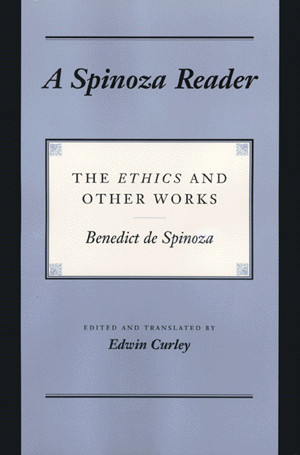Benedict de Spinoza: A Spinoza Reader: The Ethics and Other Works (1994)
Filed under book | Tags: · ethics, philosophy, religion, science

“This anthology of the work of Baruch de Spinoza (1632-1677) presents the text of Spinoza’s masterwork, the Ethics, in what is now the standard translation by Edwin Curley. Also included are selections from other works by Spinoza, chosen by Curley to make the Ethics easier to understand, and a substantial introduction that gives an overview of Spinoza’s life and the main themes of his philosophy. Perfect for course use, the Spinoza Reader is a practical tool with which to approach one of the world’s greatest but most difficult thinkers, a passionate seeker of the truth who has been viewed by some as an atheist and by others as a religious mystic.
The anthology begins with the opening section of the Treatise on the Emendation of the Intellect, which has always moved readers by its description of the young Spinoza’s spiritual quest, his dissatisfaction with the things people ordinarily strive for–wealth, honor, and sensual pleasure–and his hope that the pursuit of knowledge would lead him to discover the true good. The emphasis throughout these selections is on metaphysical, epistemological, and religious issues: the existence and nature of God, his relation to the world, the nature of the human mind and its relation to the body, and the theory of demonstration, axioms, and definitions. For each of these topics, the editor supplements the rigorous discussions in the Ethics with informal treatments from Spinoza’s other works.”
Edited and translated by Edwin M. Curley
Publisher Princeton University Press, 1994
ISBN 0691000670, 9780691000671
280 pages
PDF (11 MB, updated on 2021-6-23)
Comments (2)Cretien van Campen: The Hidden Sense: Synesthesia in Art and Science (2007)
Filed under book | Tags: · art and science, brain, cognition, music, neuropsychology, perception, psychology, science, synaesthesia, visual music

What does it mean to hear music in colors, to taste voices, to see each letter of the alphabet as a different color? These uncommon sensory experiences are examples of synesthesia, when two or more senses cooperate in perception. Once dismissed as imagination or delusion, metaphor or drug-induced hallucination, the experience of synesthesia has now been documented by scans of synesthetes’ brains that show “crosstalk” between areas of the brain that do not normally communicate. In The Hidden Sense, Cretien van Campen explores synesthesia from both artistic and scientific perspectives, looking at accounts of individual experiences, examples of synesthesia in visual art, music, and literature, and recent neurological research.
Van Campen reports that some studies define synesthesia as a brain impairment, a short circuit between two different areas. But synesthetes cannot imagine perceiving in any other way; many claim that synesthesia helps them in daily life. Van Campen investigates just what the function of synesthesia might be and what it might tell us about our own sensory perceptions. He examines the experiences of individual synesthetes—from Patrick, who sees music as images and finds the most beautiful ones spring from the music of Prince, to the schoolgirl Sylvia, who is surprised to learn that not everyone sees the alphabet in colors as she does. And he finds suggestions of synesthesia in the work of Scriabin, Van Gogh, Kandinsky, Nabokov, Poe, and Baudelaire.
What is synesthesia? It is not, van Campen concludes, an audiovisual performance, a literary technique, an artistic trend, or a metaphor. It is, perhaps, our hidden sense—a way to think visually; a key to our own sensitivity.
Publisher MIT Press, 2008
Leonardo Books series
ISBN 0262220814, 9780262220811
185 pages
PDF (updated on 2013-3-19)
Comment (0)Rich Gold: The Plenitude: Creativity, Innovation, and Making Stuff (2007)
Filed under book | Tags: · art, design, science, technology, ubiquitous computing

We live with a lot of stuff. The average kitchen, for example, is home to stuff galore, and every appliance, every utensil, every thing, is compound—composed of tens, hundreds, even thousands of other things. Although each piece of stuff satisfies some desire, it also creates the need for even more stuff: cereal demands a spoon; a television demands a remote. Rich Gold calls this dense, knotted ecology of human-made stuff the “Plenitude.” And in this book—at once cartoon treatise, autobiographical reflection, and practical essay in moral philosophy—he tells us how to understand and live with it.
Gold writes about the Plenitude from the seemingly contradictory (but in his view, complementary) perspectives of artist, scientist, designer, and engineer—all professions pursued by him, sometimes simultaneously, in the course of his career. “I have spent my life making more stuff for the Plenitude,” he writes, acknowledging that the Plenitude grows not only because it creates a desire for more of itself but also because it is extraordinary and pleasurable to create.
Gold illustrates these creative expressions with witty cartoons. He describes “seven patterns of innovation”—including “The Big Kahuna,” “Colonization” (which is illustrated by a drawing of “The real history of baseball,” beginning with “Play for free in the backyard” and ending with “Pay to play interactive baseball at home”), and “Stuff Desires to Be Better Stuff” (and its corollary, “Technology Desires to Be Product”). Finally, he meditates on the Plenitude itself and its moral contradictions. How can we in good conscience accept the pleasures of creating stuff that only creates the need for more stuff? He quotes a friend: “We should be careful to make the world we actually want to live in.”
Publisher MIT Press, 2007
Simplicity: Design, Technology, Business, Life series
ISBN 0262072890, 9780262072892
111 pages
PDF (updated on 2012-11-19)
Comment (0)
